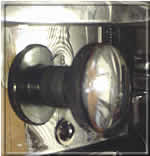This question comes up a lot so I will give you some ways
to determine what your drum is made of.
Let's start by saying most popular drum manufacturers prior
to 1960 were using brass for their shells. I say "Most"
not all! I did have a 60's Sonor that was steel, a 60's Ajax
that was steel etc..
So is my drum shell brass? Well, you can do some tests to make
that determination. Firstly and the most common method is the
Magnet Test.
To do this correctly you will need a low grade magnet. For
me a skinny flat refrigerator magnet works best. If it sticks
or gives some noticeable resistance then your drum is NOT brass,
it is steel. You can do this test on the hoops, lugs and strainer
as well to see if they are brass or steel.
If it does not stick then it can be brass, aluminum, or some
metal combination that Ludwig used called Ludalloy.
Let's discuss Ludwig a little bit since that is the most asked
question about the Ludwig Supraphonic. Is my Supra brass? Here
is a little chart to answer some general rules when looking
at a supra
| Shell |
Brass Shell |
Ludalloy |
|
| Tone Control |
Round Knob (small) |
Baseball Bat |
|
| Badge |
Keystone no serial number |
Keystone, Blue Olive |
|
| Snare Beds |
Flange Crimped Inward |
Crimped different |
|
| Chrome |
No pits at all |
Pits on the shell |
|
I know, I know, you have a (fill in the blank) drum
that is brass, but... We all know there are anomalies and situations
that do not apply to the general rules of vintage drums! Let's
get past that.
So I did mention other tests to definitively make that determination,
because there are 70's brass Supras and the rumor is that they
were special order or endorser drums. They can also be chromed
shells that were ordered instead of the Black Beauty shell,
which was brass.
This test called the Cutting Test will require
a steady hand and a little more work. You will need to take
off the head and one lug and look at the hole that the lug sits
in. Now, take a very sharp knife and or metal type cutting tool
and very, very carefully scrape the metal on the inside of the
hole. I say scrape, but more like take a fine cutting sample.
You will know right away if you see brass.
I have never done this before and only can mention what I have
heard, so this would be a last resort.
Another test is the Weight Test. The brass
shell Supras weigh more then the Ludalloy version. How much
I do not know for sure, but I have seen and heard the brass
drums are around 8-9 lbs or so and the Ludalloy versions are
5-6 lbs or so.
Other then that in some cases Ludwig Stamped a " B"
in some shells and a " BR ", I have never seen the
stamp and have heard of it on the inside of the shell, by the
strainer and just recently someone emailed me because they had
a " B " stamped above the tone control.
So with all of that said the reason the brass drums are so
popular and sought after is because they are worth more money.
Since the vintage drum market goes up and down, I have seen
some sell as low as $600 and at one time they usually went for
about $1000.
David
Webmaster
The " B "
stamp behind the tone control |
|
|
 |
|
|
| Photo Courtesy: Lenny
Sanchez from Kyle Tx |
|
|
|

